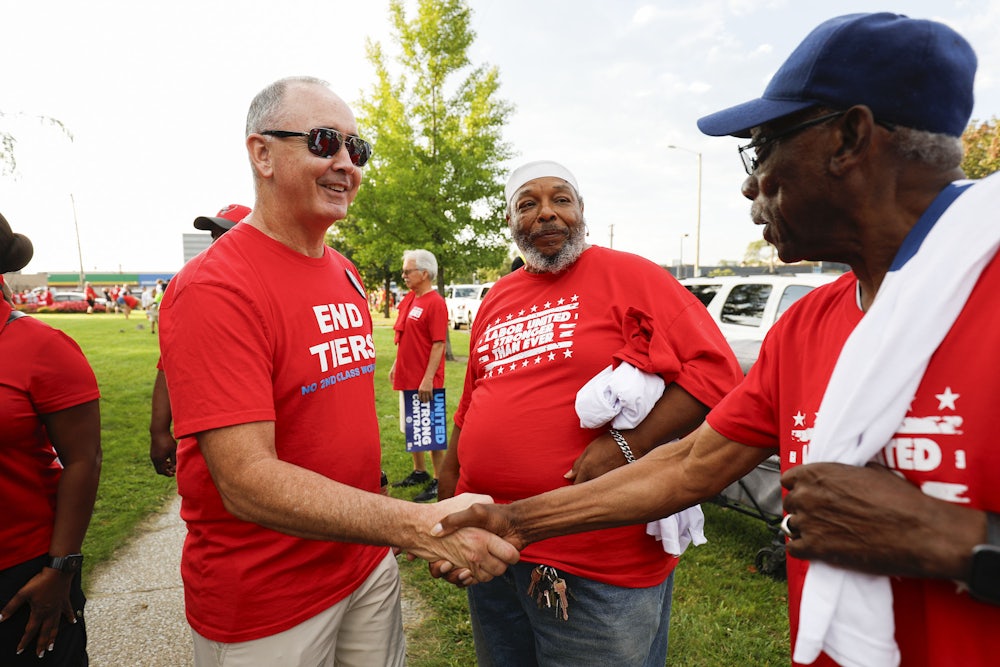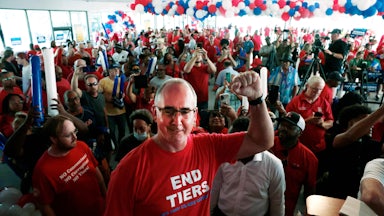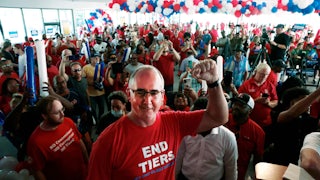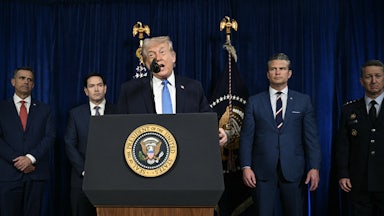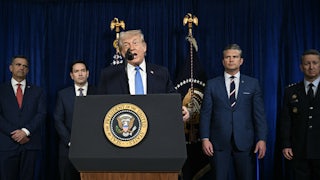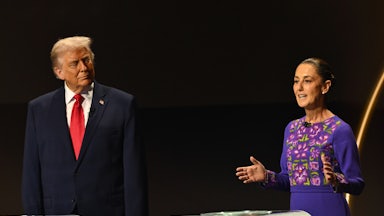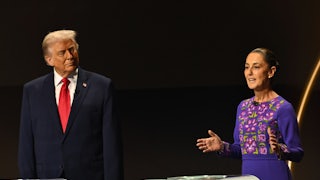The United Auto Workers strike that began this morning at midnight with UAW President Shawn Fain declaring a “defining moment” in the union’s history is a repudiation of the givebacks that the union agreed to from 2007 to 2009. But the strike’s deeper roots lie in the historic agreement struck between the UAW and the Big Three automakers in 1950, remembered today as the Treaty of Detroit.
The UAW has put forth a set of demands that even UAW chief Shawn Fain says are “audacious.” These include a 36 percent pay hike (down from an earlier 40 percent), a 32-hour workweek, restoration of cost of living increases, restoration of defined-benefit pensions, and the elimination of pay tiers.
Except for the 32-hour workweek, these demands all reverse concessions that the UAW made a decade and a half ago as GM and Chrysler (now Stellantis) tumbled into bankruptcy. The pay tiers, with new hires coming in at lower starting salaries and with fewer benefits, were established in 2007. That’s also when defined-benefit pensions were replaced with stingier defined-contribution pensions. The cost of living increases were suspended in 2009.
But while a 35 percent pay hike may sound audacious, under the current contract, starting pay—at $18 per hour—is about 36 percent below where it would be if the 2007 starting wage had kept up with inflation. Regardless, pay packages for the Big Three’s chief executives all rose 40 percent over the past decade. Fain’s ambitious wage target appears to be having the desired effect. It pushed Ford’s offer up from a 9 percent wage hike to 20 percent, GM’s from 10 percent to 18 percent, and Stellantis’s from 14.5 percent to 17.5 percent. Still, Fain said on Facebook Wednesday night, “their proposals don’t reflect the massive profits that we generated for these companies.”
There’s nothing wrong with a business enterprise in financial distress seeking concessions from its workers, as GM and Chrysler did during the Great Recession of 2007–2009. Nor is there anything wrong with a union agreeing to such concessions, as the UAW did. But as the Big Three prospered over the following decade and a half, they never seriously considered making autoworkers whole again—let alone cutting them in on the proceeds of the boom period those workers helped summon into being. Since 2013, profits at the Big Three have risen 92 percent, according to the nonprofit Economic Policy Institute. During that time period, the companies paid out nearly $66 billion in dividends and stock buybacks, $14 billion of that in this year alone. One of the UAW’s more creative demands is that workers receive $2 in profit sharing for every million dollars the Big Three spend on stock buybacks and dividends. That would mean at least $28,000 per worker this year.
How does this relate to the Treaty of Detroit? That coinage was Daniel Bell’s. Bell, later a distinguished sociologist at Columbia and Harvard, was a labor editor at Fortune back in 1950. It was, Bell wrote, “the first major union contract that explicitly accepts objective economic facts—cost of living and productivity—as determining wages.” It also included company-funded pensions and health insurance, at that time something of a novelty for working stiffs. After a series of strikes led by UAW President Walter Reuther, the Big Three agreed to fund both. Now, excepting health insurance, all these hard-won benefits are gone.
The Treaty of Detroit and the negotiations that led up to it established the precedent of pattern bargaining, wherein the UAW would negotiate, sequentially, a single contract with all three major auto companies. This prevented the Big Three from short-changing workers to compete. But as labor historian Nelson Lichtenstein told me, in recent years “the pattern got very ragged.” (Lichtenstein is the author of an excellent 1995 biography of Reuther and, more recently, of A Fabulous Failure, a history of the political economy under President Bill Clinton.)
Fain freshened up the pattern-bargaining model by negotiating with the Big Three simultaneously. That positioned the UAW to strike all three companies at the same time, something that’s never happened before. But Fain is directing the strike to proceed in stages, starting today with three plants and then spreading over time to more, to tighten the noose slowly on recalcitrant management. Fain calls these targeted actions “stand-up strikes” in a nod to the abrupt sit-down strikes that the UAW used to organize the Big Three in the 1930s.
In Lichtenstein’s view, Fain is channeling Reuther in two ways. First, he’s conceived this strike as benefiting a group much larger than the 150,000 autoworkers represented by the UAW. Reuther’s pattern-bargaining model was quickly adopted by the United Steelworkers back when steel was still dominated by a few large American players. Fain is trying to create a model wherein the electric vehicle industry, and especially the makers of the battery cells that power E.V.s, staff their plants with union workers who enjoy the same salary and benefits as the UAW rank and file.
The Big Three have resisted this, citing as their excuse that they’re developing battery cells in joint ventures with foreign companies from South Korea and elsewhere. They can’t, they say, impose a UAW contract on partners that play no role in UAW contract negotiations.
Which brings us to the second way that Fain is channeling Reuther. After World War II, Reuther pressed for higher wages while simultaneously urging the still-extant wartime Office of Price Administration, or OPA, to bar the Big Three from raising prices on automobiles. Management was outraged that a union leader would presume to involve himself in an issue (pricing) in which the union had no direct stake. But the union did have a stake, insofar as UAW workers wanted cars to remain affordable for themselves and the rest of the working class. The emerging European model of labor unions working in collaboration with management and government held no appeal for the Big Three, and the OPA got shut down before Reuther’s plan could be implemented.
Fain’s version of this is that he’s trying to leverage the 2022 Inflation Reduction Act to compel electric battery makers to employ union labor. The law has already handed out more than $100 billion in tax credits targeted to the makers of battery cells. The Biden administration recently granted preference to union shops on a $15 billion package of loans and funding for E.V. conversion, but it did not require union shops. The UAW wants Biden to require them, and it’s withholding a 2024 endorsement from him to exert pressure.
It isn’t clear Biden has the legal authority to do so. On the other hand, he has a reputation to defend as a friend to labor—a reputation he can’t afford to compromise heading into his 2024 reelection campaign. This strike will apply at least as much pressure on Biden to bend as it does on the Big Three auto companies. That’s asking a lot, and perhaps too much, of the most pro-labor president since Harry Truman. It may not work. Still, it’s glorious to see an American labor leader thinking big again.
